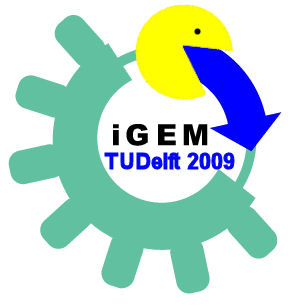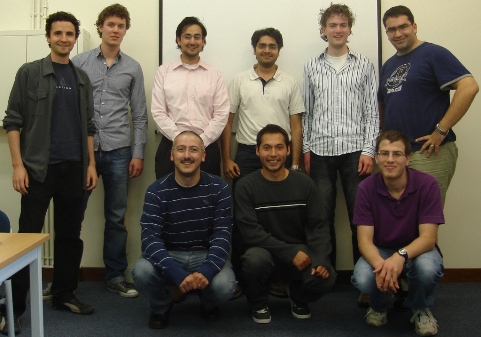Team:TUDelft
From 2009.igem.org
Many pages are under construction. Kindly excuse us.
Home
This is the first template of the TU Delft 2009 iGEM team wiki! On this page information about the project and its progress can be found.
The Team
This is the second year the TU Delft participates in the iGEM competition. The group consists of : (list of members to come here)
a number of instructors and a lot of advisors, willing to help out and think with us when this is necessary. An overview of the people involved and our competences can be found on the team page.
The Meetings (as the meetings section, I can not understand my difference with the notebook section...)
Minutes, action points
April 7th, 2009
Orr
- Bologna 2008 - Ecoli.PROM: an Erasable and Programmable Genetic Memory with E. coli
The Bologna team created here a genetic memory for E.coli that would switch between two states as a response to a certain signal (a UVc signal would inhibit Lex A (an inhibitor of LacI), thus allowing the production of LacI, whereas an IPTG signal would inhibit LacI and allow the production of TetR).
- Cambridge 2008 - iBrain: Foundations for an Artificial Nervous System using Self-Organizing Electrical Patterning
In this project, the Cambridge team decided to do three simultaneous sub-projects: one involved the creation of an artificial neurological system for E.coli (using potassium channels to transfer the ion and thus allow for a gradient of the ions), the second involved generating Turing patterns in order to integrate two signalling systems into Bacillus subtilis, and the third part involved generating standardized tools and techniques for B. subtilis. We learned from this project an important lesson: quality is definitely more important than quantity, and there is no point of doing many simultaneous experiments if we cannot finish any one of them properly.
- KULeuven 2008 - Dr. Coli, the bacterial drug delivery system
In this project, the KU Leuven team presented the idea of using E.coli as a transporter of medication in such a way that it would be targeted at a specific location. Furthermore, the E.coli would react to the presence of foreign organisms and would express certain proteins to destroy them, followed by it's self destruction after the area would be completely cured. It is important to emphasise that the project was not intended to produce a specific medication to a specific disease, but merely as a way to show that the general concept of curing a disease in a direct manner is possible.
Sriram
- Illinois - Biomolecular fluorescence biosensor system: cell bases biosensor system
- Ljubljana, Slovenia - Virotrap - A synthetic biology approach against HIV
- Ljubljana, Slovenia - Engineered Human cells - say no to sepsis
Tim Weenink
- ESBS Strasbourg - Binary generation counting in Yeast
- University of Ottowa - Puslegenerator in Yeast
- Calgary Wetware - Quorum coupled bacteriocin release (engineering a champion)
17th April 2009
Tim Vos
- MIT - Biogurt: A Sustainable and Savory Drug Delivery System
- Groningen - Conway’s Game of Life in real life
- UFreiburg - Modular Synthetic Receptor System
Daniel
- Harvard - bactricity
- ETH Zurich - Random walks towards the minimal genome
- Slovenia - Immunobricks
Saeed
- Caltech - Engenering multi-functional probiotic bacteria
The human gut houses a diverse collection of microorganisms, with important implications for the health and welfare of the host. They aimed to engineer a member of this microbial community to provide innovative medical treatments. Our work focuses on four main areas: (1) pathogen defense either by expression of pathogen-specific bacteriophage or by targeted bursts of reactive oxygen species; (2) prevention of birth defects by folate over-expression and delivery; (3) treatment of lactose intolerance by cleaving lactose to allow absorption in the large intestine; and (4) regulation of these three treatment functions to produce renewable subpopulations specialized for each function. E-Coli a non-pathogenic microbe in the guts. Nissle 1917 is a commercially available[2] non-pathogenic, probiotic strain of E. coli. Oxidative Burst.
In order to help guard against infections of the gut, we wish to engineer a strain of E. coli capable of killing bacterial pathogens. White bloodcells are able to do this, but they do migrate to large intestinal lumen where pathogens can reside. Since E-coli is adapted to this environment, it is a good candidate .
Acylhomoserine lactones(AHL) are small communication molecules between bacteria. AHL is able to diffuse across membrane. This communication system contains two main components LuxI, an AHL producer and LuxR an AHL dependent transcriptional activator. Engenired E.Coli strain is able to detect AHL from pathogens. This pathogen detection activates pyruvate oxidase which uses pyruvate to produce hydrogen perioxide, to kill the pathogens. An E.Coli catalase was used to protect the cell from cells killing, so they first were able to accumulate hydrogen perioxide before oxidative burst otherwise perioxide production would lead killing of the cell only.
LuxR activates several gene including LuxI. Here they used LuxR in a sensing mechanism.
When LuxR binds AHL its will overexpress hydrogen perioxide coding genes.
Entire system was onto a high copy plasmide in E.Coli.
They showed the system is able to detect and kill pathogens by a coculture assay. They have successfully demonstrated the overproduction of hydrogen peroxide in E. coli (JI377) using the pyruvate oxidase from S. pneumoniae. This “oxidative burst” is sufficient to kill a competing strain of JI377 cells in co-culture assays
Difficulties: The most surprising finding was that the cells began expressing hydrogen peroxide a full hour before they were induced with AHL. The current hypothesis is that some component of the rich SOC media mimicked AHL and activated LuxR. However, no such autoinduction occurred in the defined minimal media M9. It would be interesting to see if LuxR spontaneously activates expression in a rich defined media
Production of hydrogen peroxide is not a normal occurrence in the large intestine, and its effects would need to be investigated before the engineered strain could be used to fight fection.
- Heidelberg - Ecolicense to kill
- Valencia - Hot Yeast
Idea: Heat is vital for life. Some organisms are able to maintain their internal temperature constant, while other not. UCP1, thermogenin is a mammalian uncoupling protein in the mitochondrial inner membrane. When protons pass through the UPC complex instead of the ATP synthase complex they produce heat instead of ATP. They tried to express the UPC1 in a S.cerevisiae strain, so this strain would be able to maintain its temperature constant in a given range.
Applications:
- A cell which is able to maintain its own temperature so no external heating would be necessary, this could reduce the electrical costs in a lab.
- The system could be implement in some plant species. If a plan6 would be able to maintain its own temperature it could grow in a colder temperature or survival frost.
1)
In order to detect and measure temperature production they build a Liquid Cultured Calorimeter(LCC). Therefore they used commercial thermo flasks, isolation material(Armaflex), hardware and software. The isolation material Armaflex caused some problems because it reacts with water.
2)
They build a UPC + strain, a UPC - strain and two mutants. Gly 76 and Gly 175 mutant(deletion in 76 or 175 Gly triplet). LCC experiments showed that the two mutants where able to heat up there own medium compared to the UPC + and UPC- strain. Growth kinetic experiments were done ass well. These showed that the UPC + and the two mutants growth much slower than the UPC – strain, due to uncoupling and thus no ATP production.
They made a PROPOSAL FOR A CODE OF ETHICAL PRACTICES FOR SYNTHETIC BIOLOGY BASED ON THE HOT YEAST PROJECT.
| You can write a background of your team here. Give us a background of your team, the members, etc. Or tell us more about something of your choosing.
Welcome to the Wiki of the TU Delft team for iGEM 2009. The site is still under construction, but as soon as it is finished, we hope to keep with the standards of the TU Delft team last year. | |
|
With our 7 participants and 4 instructors, we are enthusiastic to start working on our project (whatever it may be). | |
| Team Example |
 "
"









